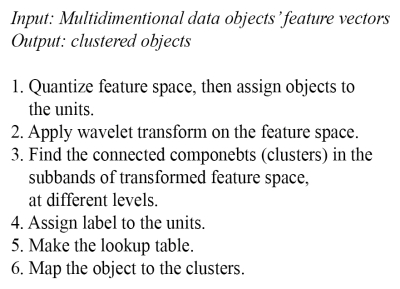The WAVE clustering algorithm is a grid-based clustering algorithm. It depends on the relation between spatial dataset and multidimensional signals. The idea is that the cluster in a multidimensional spatial dataset turns out to be more distinguishable after a wavelet transformation, that is, after applying wavelets to the input data or the preprocessed input dataset. The dense part segmented by the sparse area in the transformed result represents clusters.
The characteristics of the WAVE cluster algorithm are as follows:
- Efficient for a large dataset
- Efficient for finding various shapes of clusters
- Insensitive to noise or outlier
- Insensitive with respect to the input order of a dataset
- Multiresolution, which is introduced by wavelet transforms
- Applicable to any numerical dataset
The WAVE cluster algorithm performs a few steps. In the first step, it creates a grid and assigns each data object from the input dataset to a unit in the grid. And then, transform the data to a new space by applying wavelet transform functions. Third, find the connected component in the new space. Map the cluster label for related data object to the original data space.
Please take a look at the R codes file ch_06_wave.R from the bundle of R codes for the previously mentioned algorithm. The codes can be tested with the following command:
> source("ch_06_wave.R")
An entity possesses a couple of features. Features might be explicit or implicit. If a person or organization expresses an opinion, then the person or organization should be an opinion holder. An opinion specific to a feature is a positive or negative view, attitude, emotion, or appraisal of the feature from the opinion holder. Whether the opinion on a feature is positive, negative, or neutral denotes opinion orientation.
Opinion mining means mining the opinion on certain features of the object or entity under research. The simplest case is to judge the opinion as positive or negative.
An opinion-orientation algorithm can be listed as follows:
- Identify opinion words and phrases
- Handle negation
- The But clause
- Aggregating opinion

The preceding formula denotes the opinion orientation on a certain feature, ![]() , where
, where ![]() is an opinion word in s,
is an opinion word in s, ![]() is the distance between
is the distance between ![]() and
and ![]() .
. ![]() is the opinion orientation.
is the opinion orientation.

